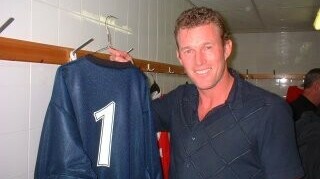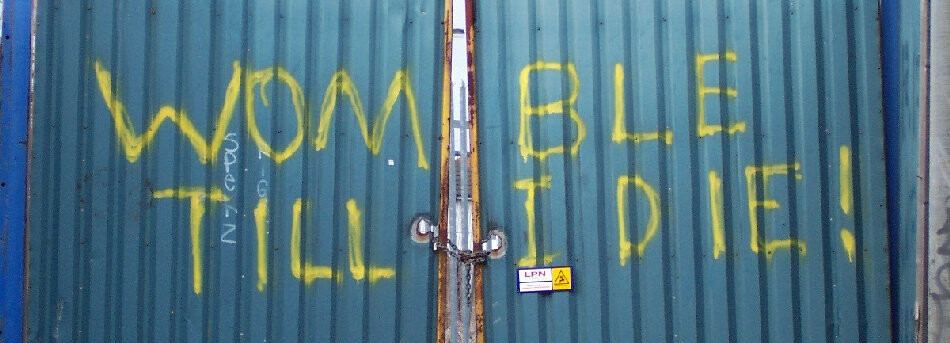
In the 1970s there had been three genuine upsets. In 1973 it had been Ian Porterfield’s goal for Bobby Stokoe’s second-division Sunderland against the mighty Leeds United. In 1976 Southampton’s Bobby Stokes goal was enough to defeat Manchester United and then two years later, Roger Osborne’s goal defeated Arsenal to see Ipswich Town captain Mick Mills lift the trophy. Into the 1980s, we saw the victory of second-division West Ham over Arsenal in 1980.
Eight years later on 14 May 1988, there was the mother of all upsets. A proper David versus Goliath tale unfolded on the famous green of Wembley Stadium. Wimbledon, non-leaguers just a decade previously, were facing a true footballing giant in Liverpool in the 1988 FA Cup Final. It was a match destined to be writ large in the record of football history, not only for the outcome but for its symbolism in the wider sporting world.
That fateful day, the air was thick with anticipation as the two teams took to the pitch. Wimbledon, known as the ‘Crazy Gang’ for their exuberant and unconventional approach, were the clear underdogs. But don’t worry too much about the labels; what transpired over the next 90 minutes would challenge every expectation. The pivotal moment of the match came after 37 minutes when Lawrie Sanchez rose to meet Dennis Wise’s floated left-wing free kick. His header eluded Bruce Grobbelaar and nestled in the back of the net. 1-0 Wimbledon.
Just two minutes before Sanchez scored the only goal, Peter Beardsley had scored past Dave Beasant with a cute chip. However, referee Brian Hill had spotted a foul on the Liverpool number 7 by Wimbledon’s Andy Thorn. Instead of playing advantage and letting the goal stand, he awarded Liverpool a free kick from which nothing came.
The second half was the story of Liverpool’s huff ‘n puff as they tried to break down the Wimbledon door. But try as they might, Wimbledon stood firm. On the hour mark, John Aldridge was adjudged to have been fouled by right-back Clive Goodyear. Penalty!
Alas, it was not to be as Beasant pulled off the save of saves (well, ok a half-decent leap to his right) to make history as for the first time, an FA Cup Final penalty was not dispatched. Did Hill award the kick to make up for his first-half error? Did John Aldridge know deep down that perhaps he had not been fouled by Goodyear? Perhaps and maybe. However, accepting either argument would deny Beasant his credit for his historic save.

As the final whistle blew, it wasn’t just a victory for Wimbledon – it was a testament to the ability of teamwork to overcome individual brilliance; for what can be achieved with spirit and application. It was a dramatic reminder of football’s unpredictability and the genuine hope that underdogs can triumph in the face of overwhelming odds.
The final at Wembley is always the climax of the FA Cup season which starts within only a few weeks of the previous year’s final. First, let’s take a look at the teams’ respective paths to their day in the north London sunshine.
Liverpool’s Journey to Wembley
In the 1988 FA Cup, Liverpool and Wimbledon walked very different paths to reach the iconic steps of Wembley Stadium. Liverpool, a seasoned giant with numerous accolades, was expected to add another trophy to their showcase. Wimbledon, on the other hand, was treading relatively new ground, and their trip to Wembley was draped in a spirited underdog narrative.
Liverpool’s FA Cup campaign showcased their prowess and reinforced their reputation as a formidable force in English football. The team, skilled in controlling matches and dispatching opponents, faced a variety of challengers. En route to the final, their line-up under manager Kenny Dalglish displayed both strategic depth and individual brilliance.
So, here we go. In the third round, the place where the biggest teams in England join the quest for FA Cup glory, Liverpool were drawn away against Stoke City. After a goalless stalemate at the Victoria, Liverpool went through after a 1-0 win at Anfield. Peter Beardsley netted the goal after just 9 minutes.
A fourth-round tie versus Aston Villa in the midlands went Liverpool’s way 2-0 with goals from John Barnes and Beardsley. Next up was another away tie, but only as far as Goodison Park where Ray Houghton’s goal was enough to put the Reds into the sixth round.
Liverpool’s sixth-round tie was another away fixture, this time at Maine Road. This was the Red Machine in full effect as the hosts were demolished 4-0 with goals from Houghton, Beardsley, Craig Johnston, and Barnes. So, it was another semi-final date, their third in the last four seasons.
Their opponents would be Nottingham Forest who had defeated Arsenal at Highbury to earn their place. At Hillsborough, the home of Sheffield Wednesday, Liverpool went two up through John Aldridge’s goals. Nigel Clough’s goal made it a sticky last 23 minutes, but Liverpool held out to book their Wembley tickets.
Wimbledon’s Journey to Wembley
Wimbledon’s path to Wembley started with a 4-1 humping of West Bromwich Albion at Plough Lane before their fourth-round match away at Mansfield Town. The Dons navigated this potential banana skin with goals from Alan Cork and Terry Phelan either side of half time. The reward was a tricky away tie at St James’ Park, Newcastle. However, goals from Terry Gibson and Brian Gayle were replied to by Neil McDonald before John Fashanu sealed the tie with a deft lob over Gareth Kelly in the Newcastle goal.
In the sixth round, Wimbledon played Watford at home, running out 2-1 winners. They were made to work hard for their victory by the division one strugglers. Eric Young equalised Malcolm Allen’s opening goal before John Fashanu scored the winner. Perhaps it was written that they would win the Cup this season as they prevailed over Watford with 10 men after Brian Gayle was sent off for a whack across the neck of the Watford scorer. At this stage in the game the Dons were still trailing.
Wimbledon drew Watford’s neighbours Luton Town in the semi-final after they had defeated Portsmouth at Kenilworth Road in their sixth-round tie. The match at White Hart Lane was won 2-1 by Wimbledon, again after having conceded first. John Fashanu’s penalty answered Mick Harford’s opening goal, and a strike from Dennis Wise was enough to seal their place at Wembley.
Defying Giants: The Upset of the 1988 Final
Prior to the final, the 1987/88 FA Cup had been curiously devoid of act of giant-killing. So, you could say, that the season was due one. Liverpool, winners of the double in 1986 and already League Champions this season, were aiming to add the FA Cup to it – another double.
At the time that Liverpool had done the double in 1986, it was a feat only completed four times previously, by Preston NE in 1889; Aston Villa in 1897; Spurs in 1961 and Arsenal in 1971.
If you want to talk about the epitome of the rags to riches stories in football, let’s not look any further than the 1988 Wimbledon team. Having gained membership of the Football League only in 1977 after winning a hattrick of Southern League titles, theirs was also nothing if not a meteoric rise. Context is provided with the knowledge that also in 1977 Liverpool had scaled the heights of European football by becoming European Champions at the expense of Borussia Mönchengladbach in Rome.
As we move on to the last section, we will briefly discuss the dichotomy of what happened to Wimbledon since 1988 and its potential ramifications for the future of the game. After such a monumental win over one of the giants of English football, you might think the only way is up. But life is not a fairy tale, and Wimbledon and their fans were brought down to earth with a series of twists and turns; or, more likely, bangs and bumps.
Beyond the Upset: Wimbledon FC’s Evolving Saga
In the years following their stunning FA Cup win, Wimbledon FC navigated through fluctuating successes and challenges. Their story is not just about a single match, it’s also about the determination to preserve a cherished community institution amidst adversity.
The controversial move to Milton Keynes in 2003, in effect the sanctioned franchising of a football club, marked a turning point, as the club was rebranded as MK Dons. Financial considerations aside, for many die-hard fans, this was a step too far.

Consequently, a group of dedicated supporters launched AFC Wimbledon, ensuring that the spirit of their original team lived on. This move sent ripples through the football world and demonstrated that fans do sometimes still have power in modern sport.
Today, AFC Wimbledon stands as a testament to what can be achieved with unwavering passion and community effort. Launched in 2002 as a response to the FA’s sanctioning of the move to Milton Keynes, the club has climbed from the lower leagues back up the ranks. Their first season in existence was played in the Combined Counties League Premier Division, where they finished a very creditable third.
Their second season saw them win that division to get promoted to the Isthmian League Division One, which they won the subsequent season. It took them just three seasons to gain promotion from the Isthmian League Premier Division into the Conference South which they won at the first attempt. Next stop was the Conference, just one step towards gaining entry to the Football League.
AFC Wimbledon was promoted to the Football League after just two seasons in the Conference. Put into proper perspective, this was after just nine seasons of existence. With each match played, the new club seemed to channel the spirit of 1988.
The inevitable happened, appropriately enough, in the second round of the FA Cup in 2011/12 on 2 December 2012 when AFC Wimbledon were drawn away at MK Dons. This time, there was no fairy tale ending as MK Dons won 2-1.
In conclusion, the question on everybody’s lips is, “Which club is the true heir of the Wimbledon of 1988?” In strict legal terms it is MK Dons. But football purists and all of those of a romantic bent, would argue that AFC Wimbledon, albeit newly formed only in 2002, deserved the title. After all is said and done, the club plays on Plough Lane (near to, but not on, the site of the original stadium) and like the original Wimbledon FC, plays in all blue.
